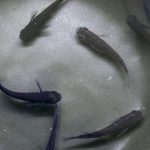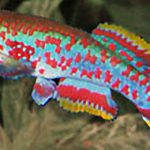Description
Medaka Red Emperor is a selectively bred strain of the Oryzias latipes, commonly known as the Japanese rice fish or medaka. This particular strain is highly prized for its vibrant red color, making it a standout variety among hobbyists and collectors of ornamental fish.
Key Characteristics:
- Appearance: The Medaka Red Emperor is distinguished by its intense, vivid red or orange body coloration. Its scales often have a metallic sheen that adds to its attractiveness under aquarium lighting.
- Size: Like other medaka fish, they typically grow to about 3 to 4 centimeters (1.2 to 1.6 inches) in length.
- Temperament: Medaka fish are peaceful, active swimmers and can coexist with other non-aggressive fish species.
- Habitat: While they naturally occur in freshwater, they are quite adaptable and can live in slightly brackish water environments as well.
- Care Level: These fish are hardy and relatively easy to care for, making them a good choice for both beginner and experienced aquarists.
- Lifespan: Medaka can live for about 3 to 5 years with proper care.
- Water Conditions: Ideal temperature ranges from 18°C to 28°C (64°F to 82°F). They prefer slightly alkaline water (pH 7.0-8.0)2 but can tolerate various water conditions.
- Breeding: Medaka Red Emperor, like other medaka fish, are prolific breeders. They spawn easily in a well-maintained tank, and the females lay eggs that attach to their bodies before being dispersed into plants or substrate.
Medaka fish, including the Red Emperor variety, are known for their resilience, making them popular in scientific research as well as home aquariums. Would you like to know more about their care, breeding, or other details?
Keeping Medaka Red Emperor fish in a garden pond
can be a rewarding experience, as they are hardy and adaptable, making them well-suited for outdoor environments. Here are some key points to consider for successfully keeping medaka in a garden pond:
1. Pond Size and Setup
- Size: Medaka do not require large ponds, but a modest-sized pond with a depth of at least 30 cm (12 inches) is recommended to provide enough water volume and stability for temperature fluctuations.
- Substrate and Plants: Adding aquatic plants like water lilies, hornwort, and anacharis can help provide cover, breeding spots, and maintain good water quality. Plants also offer shaded areas during hot weather.
- Filtration: Although medaka are hardy, a simple filtration system is beneficial to keep the water clean. A biological filter is often enough for smaller ponds.
- Aeration: Providing aeration (such as a small fountain or air stone) will improve oxygen levels, especially in the summer.
2. Water Conditions
- Temperature: Medaka are cold-tolerant and can withstand temperatures ranging from 10°C to 30°C (50°F to 86°F), though they prefer water temperatures between 18°C and 28°C (64°F to 82°F). In colder climates, it’s advised to bring them indoors during freezing winters or ensure that the pond is deep enough to prevent freezing.
- pH and Hardness: Medaka prefer slightly alkaline water with a pH of 7.0 to 8.0, but they can tolerate various conditions, making them suitable for ponds where parameters might fluctuate.
- Water Quality: Regular water changes or a filtration system will help maintain good water quality, preventing ammonia and nitrite buildup.
3. Feeding Medaka in a Pond
- Diet: Medaka are omnivores. In a pond, they will eat small insects, algae, and other natural food sources. Supplement their diet with high-quality fish flakes or pellets and occasional live foods like daphnia, mosquito larvae, or brine shrimp.
- Feeding Schedule: Feed them once or twice daily, but be mindful not to overfeed, as uneaten food can pollute the water.
4. Breeding in the Pond
- Medaka are prolific breeders, and if the pond has plenty of plants, the fish will likely breed on their own. Females carry eggs attached to their abdomen before depositing them on aquatic plants.
- You can expect to see fry (baby fish) during warmer months when breeding conditions are ideal. Fry can often be left to grow naturally in the pond.
5. Pond Maintenance
- Seasonal Care: In spring and summer, monitor water temperature, and ensure that the pond doesn’t overheat. During autumn, remove fallen leaves to prevent them from decomposing in the water. In winter, if the pond is in a cold climate, either bring the medaka inside or ensure the pond doesn’t freeze over entirely.
- Algae Control: While medaka may help control algae by grazing on it, excessive algae growth should be managed by balancing light, nutrients, and plant life.
6. Predator Protection
- If your pond is in an area where birds, cats, or other predators are common, consider adding netting or providing dense planting to give the medaka places to hide.
7. Medaka Behavior in the Pond
- Medaka are active and peaceful fish. They will often swim near the water’s surface, especially when feeding, and can be a delightful addition to an outdoor pond due to their vibrant colors and interesting behaviors.
By following these guidelines, you can enjoy having a beautiful population of medaka fish in your garden pond, where they can thrive in a naturalistic environment. Would you like suggestions for compatible plants or other fish for a medaka pond?




